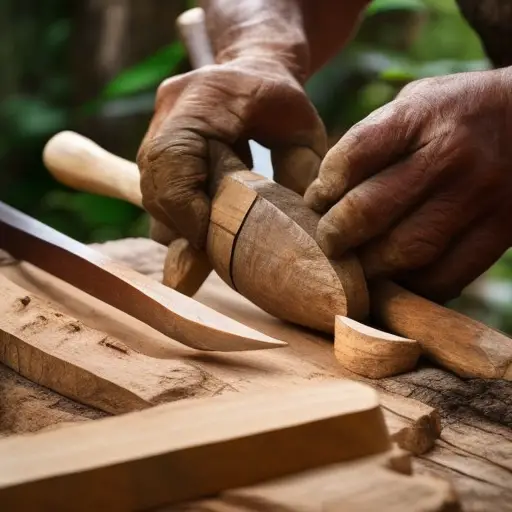Crafting Basic Tools From Natural Resources

Are you ready to tap into your primal instincts and embrace the art of survival?
In our modern world, we often forget the power of nature’s resources in providing for our basic needs. But what if we told you that you can craft essential tools for your survival using nothing but what Mother Nature offers?
In this article, we will delve into the detailed, practical, and resourceful techniques of crafting basic tools from natural resources, empowering you to thrive in the wilderness.
Choosing the Right Natural Materials
When crafting basic tools from natural resources, it is crucial to carefully select the appropriate materials for the task at hand. Natural material identification and sustainable harvesting techniques are essential in ensuring the longevity and effectiveness of the tools created.
To begin, one must have a thorough understanding of the natural materials available. Identifying the properties and characteristics of different materials enables craftsmen to make informed decisions. For example, wood can vary in density, strength, and durability based on the tree species and growth conditions. This knowledge allows for the selection of the most suitable wood for the desired tool.
Sustainable harvesting techniques also play a vital role in the process. It is important to gather materials in a way that does not harm the environment or deplete natural resources. This can involve practices such as selective cutting, where only mature trees are harvested, or replanting to ensure future availability.
Additionally, considering the environmental impact of the tool’s production is crucial. Opting for materials that are abundant and easily replenished reduces the strain on ecosystems and promotes sustainability.
Essential Knife-Making Techniques
To ensure the successful crafting of basic tools from natural resources, one must master the essential knife-making techniques that will bring precision and functionality to the final product. Here are three important techniques to consider:
-
Knife Sharpening Techniques: The sharpness of a knife is crucial for its effectiveness. There are various methods to sharpen a knife, such as using a sharpening stone or honing rod. Understanding the angle at which the blade should be sharpened and the proper technique for stroking the blade against the sharpening surface is essential. Regular maintenance and sharpening will keep the knife in optimal condition.
-
Knife Handle Design: The design of the knife handle plays a significant role in the knife’s comfort and usability. It should be ergonomically shaped to fit comfortably in the hand, providing a secure grip. The handle material should be durable and resistant to moisture and temperature changes. Consider materials like wood, bone, or synthetic materials like G10 or Micarta.
-
Handle Attachment: The method of attaching the handle to the blade is crucial for durability. Some common techniques include using pins, rivets, or adhesives. The handle should be securely attached to the tang of the blade to prevent any accidental detachment during use.
Crafting Simple Digging Tools
When it comes to crafting simple digging tools from natural resources, there are three key points to consider.
First, selecting the right natural resources is crucial, as materials like sturdy branches, rocks, and animal bones can be used to create effective digging tools.
Second, mastering tool construction techniques such as carving, shaping, and binding will ensure the durability and functionality of the tools.
Natural Resource Selection
Crafting simple digging tools requires carefully selecting suitable natural resources. When choosing the materials for these tools, it is important to prioritize natural resource preservation and use sustainable harvesting methods. Here are three key considerations for selecting the right resources:
-
Wood: Look for strong and durable wood from trees that are abundant in your region. Avoid using endangered tree species and opt for sustainable forestry practices to ensure a steady supply.
-
Stones: Seek out rocks that are hard, dense, and easily shaped. Use stones that can withstand the demands of digging without breaking or crumbling.
-
Bone: Animal bones can be excellent materials for crafting digging tools. They are strong and readily available, especially if obtained from animals that have already died naturally.
Tool Construction Techniques
One crucial aspect of crafting simple digging tools is utilizing effective tool construction techniques. To ensure the longevity and functionality of your tools, proper maintenance is essential. By employing advanced tool construction techniques, you can create durable and efficient digging tools from natural resources. Here is a table showcasing three different techniques for constructing simple digging tools:
| Technique | Materials Required | Steps |
|---|---|---|
| Wooden Handle | Sturdy branch or sapling | 1. Cut branch to desired length |
| Rope or vine | 2. Attach rope or vine to one end | |
| Knife or sharp stone | 3. Carve handle shape and smooth surfaces | |
| Stone Blade | Flat, sharp-edged stone | 1. Find suitable stone with sharp edge |
| Vine or sinew | 2. Secure vine or sinew to stone | |
| Wooden handle | 3. Attach stone blade to handle | |
| Shell Scoop | Large seashell or animal bone | 1. Find seashell or bone with suitable shape |
| Vine or sinew | 2. Attach vine or sinew to shell | |
| Wooden handle or branch | 3. Attach shell to handle or branch |
Effective Digging Methods
Utilizing the previously mentioned tool construction techniques, effective digging methods can be employed in crafting simple digging tools from natural resources. When it comes to alternative digging techniques, there are several options to consider. Here are three efficient digging tools that can be easily crafted:
-
Digging Stick: A sturdy branch can be sharpened at one end to create a digging stick. This tool is effective for loosening soil and breaking up compacted areas.
-
Hand Trowel: Crafted from a flat stone or piece of wood with a sharpened edge, a hand trowel is perfect for precise digging in small spaces or for planting seeds.
-
Shovel: A larger, more robust tool can be made by attaching a flat stone or a piece of wood to a longer handle. This makeshift shovel is ideal for digging larger holes or moving loose soil.
Building Primitive Fishing Gear
When it comes to building primitive fishing gear, there are several key points to consider.
First, you’ll need to learn how to make improvised fishing hooks using natural materials like bone, wood, or seashells.
Next, you’ll need to craft fishing lines from materials like plant fibers or animal sinew.
And finally, you can explore the option of building DIY fish traps using woven baskets or makeshift nets.
Improvised Fishing Hooks
Improvised fishing hooks can be constructed using natural resources, offering a primitive and resourceful solution for catching fish. When in a survival situation or lacking traditional fishing gear, it is essential to know how to fashion your own hooks. Here are three methods for creating improvised fishing hooks:
-
Bone Hooks: Find animal bones and shape them into hooks using a rock or sharp object. These hooks are durable and can be easily sharpened.
-
Wooden Hooks: Carve hooks from sturdy tree branches. Look for branches with natural curves or bends that can serve as the hook shape. Sharpen the end and attach a line.
-
Thorns and Spines: Use thorns or spines from plants as makeshift hooks. Select long, sturdy thorns and attach them to a line or whip them around a stick to create a barbed hook.
Making Fishing Lines
For crafting primitive fishing gear, one essential component is the creation of fishing lines using natural resources. Fishing lines are crucial for successfully catching fish, as they provide the means to cast and reel in the catch.
In a survival situation, it is important to utilize natural materials to construct fishing lines. One common method is to use plant fibers, such as long grasses or tree bark, which can be twisted or braided to create a strong and durable line. Another option is to use animal sinew or tendons, which can be stripped and twisted into a thread-like material.
Once the fishing line is constructed, it can be combined with improvised fishing hooks and natural bait to employ various fishing techniques, increasing the chances of a successful catch.
DIY Fish Traps
To continue our exploration of crafting basic tools from natural resources, let us now delve into the construction of DIY fish traps as a part of building primitive fishing gear. Fish traps are an effective alternative fishing technique that can be easily made using materials found in the wilderness.
Here are three items you will need to build a DIY fish trap:
-
Basket or container: Find a suitable container, such as a woven basket or a large plastic bottle with the top cut off. This will serve as the main structure of the fish trap.
-
Bait: Use improvised cooking methods to create a bait that will attract fish. This can include using natural ingredients like worms, insects, or pieces of food.
-
Entrance and exit: Create small openings in the trap to allow fish to enter but make it difficult for them to escape. You can use sticks or twigs to construct a funnel-like entrance.
Creating Fire-Starting Tools
One effective method for creating fire-starting tools is by utilizing the resources found in nature. In survival situations, where matches or lighters may not be readily available, knowing alternative fire starting methods can be crucial.
One such technique is the bow drill method. This method involves using a wooden bow and a spindle to create friction and generate heat. By rotating the bow back and forth, the spindle is pressed into a fireboard, creating enough friction to produce embers that can ignite tinder.
Another option is the hand drill method, which involves using a wooden spindle and a fireboard. By rapidly rotating the spindle between your palms, friction is created, resulting in glowing embers. These embers can then be transferred to a bundle of tinder, such as dry grass or bark, to create a fire.
It is important to gather suitable materials for these techniques, such as dry wood for the spindle and fireboard, as well as tinder that easily catches fire.
With these fire-starting tools, you can now move on to improvising basic shelter construction, ensuring your safety and comfort in the wilderness.
Improvising Basic Shelter Construction
A crucial step in wilderness survival is the construction of a rudimentary shelter using available natural resources. When it comes to shelter design, there are several practical options to consider. Here are three items to keep in mind when improvising a basic shelter:
-
Location: Choose a site that provides natural protection from the elements. Look for natural features such as rock formations or large trees that can serve as a windbreak. Avoid low-lying areas that may collect water.
-
Materials: Utilize the resources around you to build your shelter. Look for sturdy branches, fallen logs, or large leaves that can be used for walls, roof, and insulation. If available, use mud or clay to reinforce the structure and enhance its insulation properties.
-
Insulation: To stay warm during the night, it is crucial to insulate your shelter. Layering materials such as leaves, grass, or even pine needles can provide additional insulation. Pay attention to the floor as well, as it can sap heat from your body. Consider adding a layer of debris or a natural bedding material to keep the cold ground at bay.
Frequently Asked Questions
Can I Use Any Type of Wood for Crafting Basic Tools, or Are There Specific Types That Work Better?
When crafting basic tools, it is important to consider the type of wood used. While any wood can be used, certain types may work better due to their strength, durability, and resistance to wear. Exploring alternative materials can also provide pros and cons for tool making.
Are There Any Alternative Methods to Knife-Making That Don’t Require Using a Knife at All?
Alternative methods to knife making using non-knife tools can be employed to craft basic tools without using sharp objects. These innovative techniques are resourceful and practical, offering detailed approaches to crafting tools from natural resources.
What Are Some Creative Ways to Make Digging Tools Without Access to Any Metal or Sharp Objects?
When faced with limited access to metal or sharp objects, alternative methods for making digging tools can be explored. Creative ways to craft fishing gear using natural resources can also be utilized for survival or recreational purposes.
Is There a Specific Type of Plant Fiber That Works Best for Crafting Fishing Gear?
Different types of plant fibers can be used for crafting fishing gear. Some common options include hemp, flax, and jute. Each fiber has its pros and cons, such as strength, flexibility, and resistance to water.
Are There Any Natural Resources That Can Be Used for Fire-Starting Besides Flint and Steel?
There are several natural resources that can be used for fire-starting besides flint and steel. By exploring alternative methods and thinking outside the box, one can experiment with unconventional materials to ignite a fire in a resourceful and practical manner.
Conclusion
In conclusion, by choosing the right natural materials and utilizing essential knife-making techniques, one can craft basic tools for various purposes.
These tools can include simple digging tools, primitive fishing gear, fire-starting tools, and basic shelter construction.
With resourcefulness and practicality, anyone can learn to create these tools from natural resources, making them self-sufficient in various outdoor situations.





